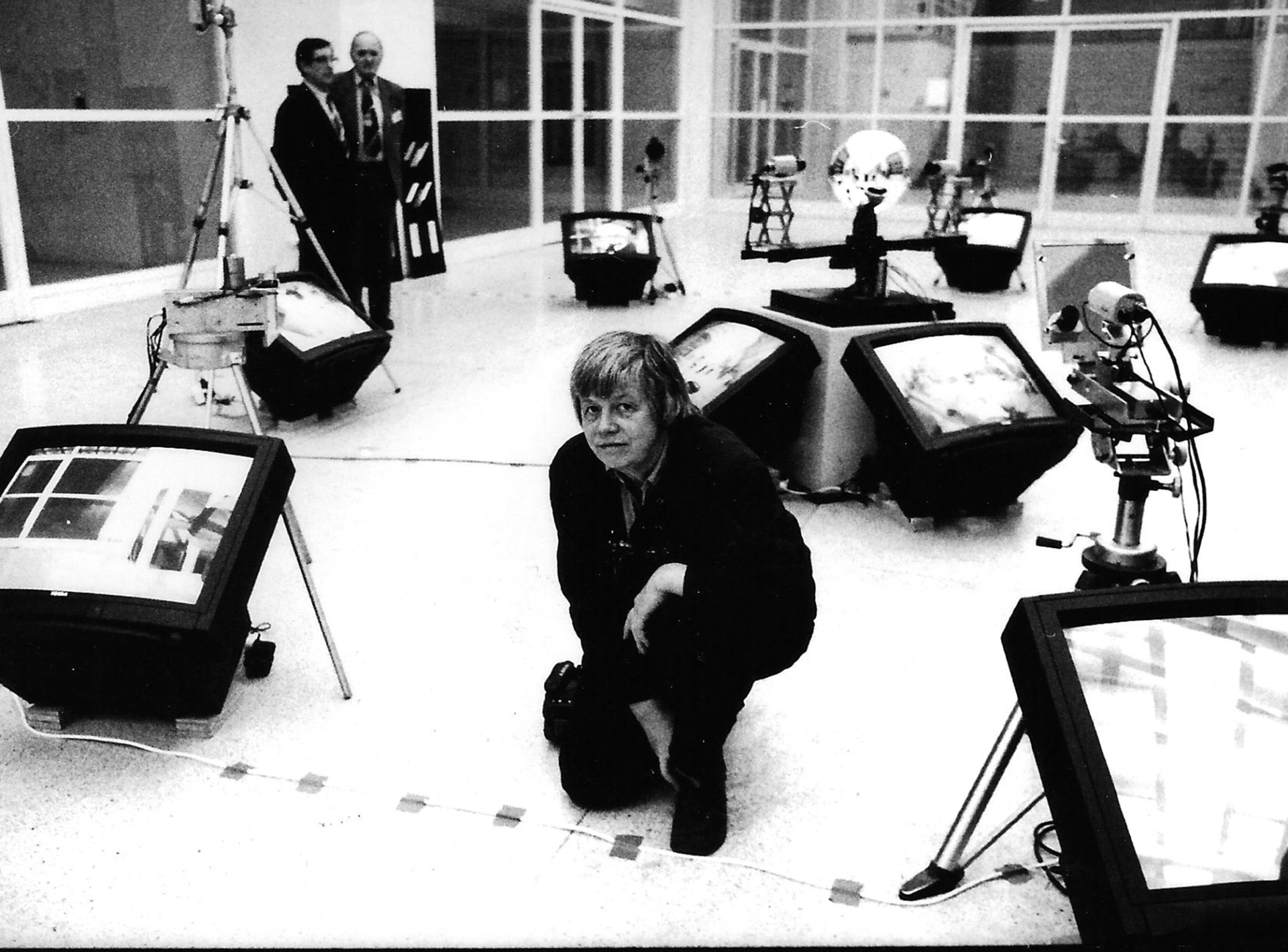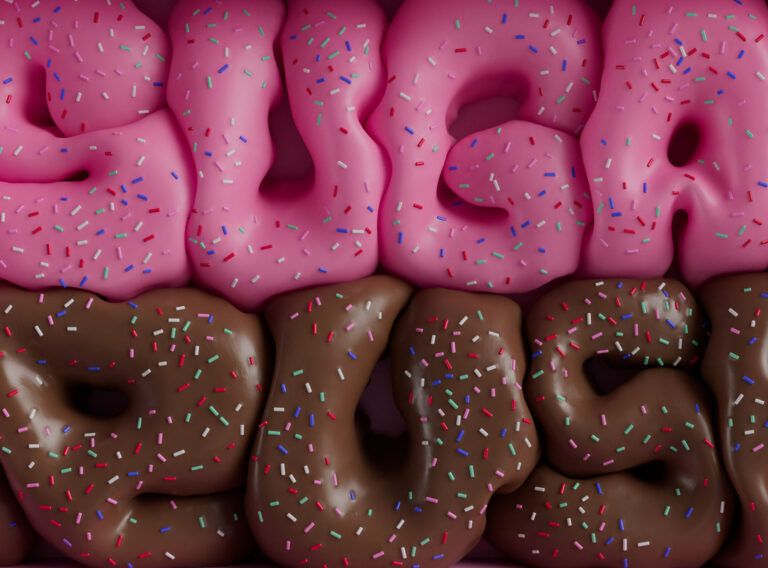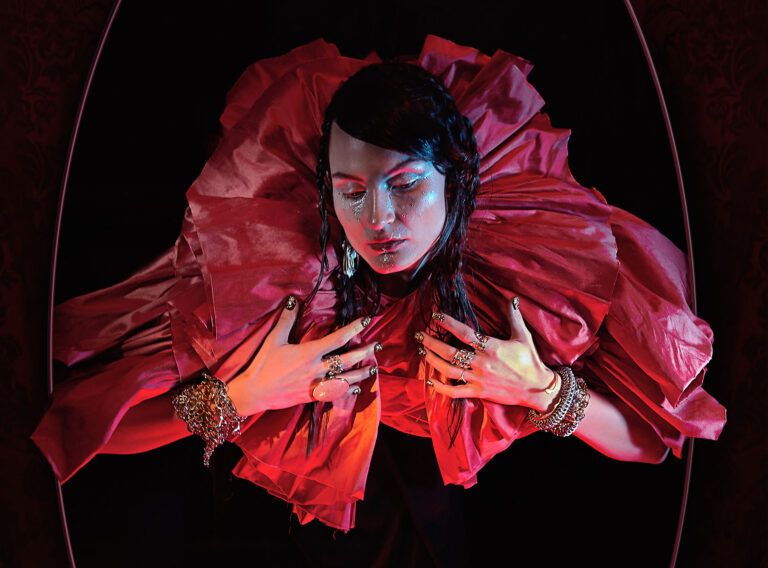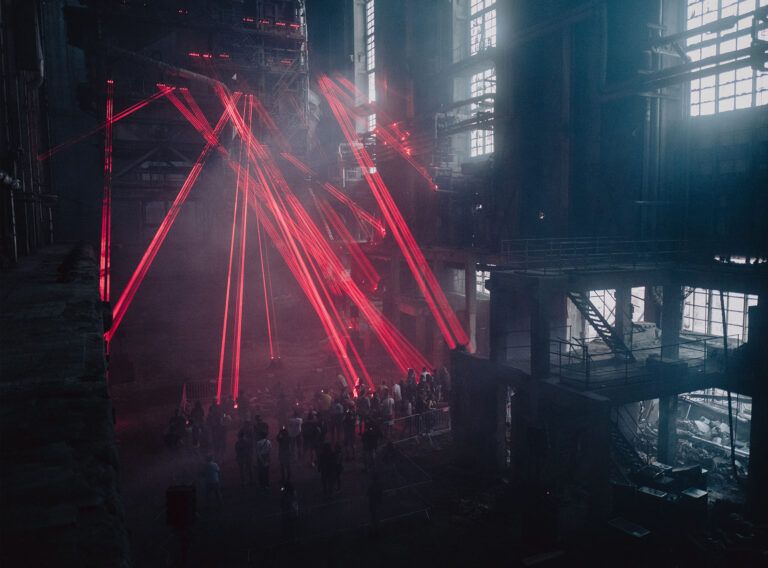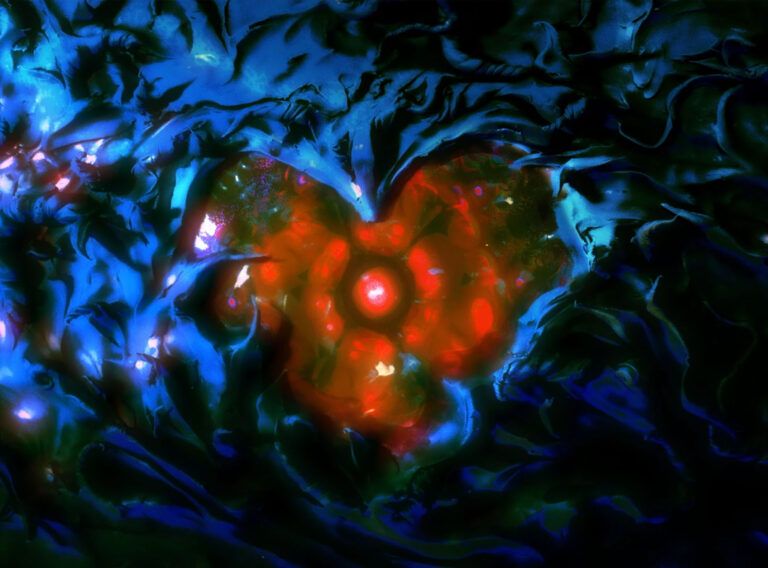Bohuslav Woody Vašulka, who died on December 20, 2019, at 82 years old in Santa Fe, spent his life working as an artist, a teacher, and as one of founders of a famous New York art space The Electronic Kitchen. Vašulka – originally a documentary filmmaker, after moving to New York in 1965 advocated for electronic image and sound as a key medium in our times. Woody and his wife Steina inspired generations of artists around the globe.
Woody Vašulka and The Art of Memory
In the media sense, space is what you create. It’s machine-made space, and these are manufactured pieces of information that are drawn into a cognitive context, and it eventually becomes a product of machinery. This carries through to the computer… (since) all modalities of space are represented in that machine by simply organizing data structures. It is basically a new territory of representation of the world… this is non-centric space.
Woody Vasulka / He was born as Bohuslav Petr Vašulka in Brno in 1937, two years before the Nazi occupation of Czechoslovakia. His formative childhood experiences of WW II (although relatively calm in the Moravian capital Brno), helped to foster his sensitivity to the relationship between an individual and the political powers that govern human lives. The six years of war meant the destruction of cities of hundreds of thousands and the disappearance of entire ethnic groups. A way of life died out, as did the credibility of concepts like ‘humanism’, ‘nation’, ‘progress’, ‘ideology’ and, to a certain extent, the interbellum style of ‘culture’. The oppressive sense of volatility; the corruption of ideological systems designed to perfect the self-destruction of human emotions; the devaluation, corruption, abuse, and appropriation of literature and visual art; the murderous perfection of technical instruments – all this under strict government control systems – these phenomena were all emblematic for the generation growing up during the war. Critical awareness of the falsification in every form of poeticizing and pathos is a distinct element of every one of Vasulka’s works and texts. The vestiges of the war machines he played with in childhood must have served as models for his later series of automatic machines and mechanisms. The author finished, transformed and altered the constructions, saddling them with a different purpose and meaning than they originally had as instruments of military technology of destruction.
After graduating from a specialized technical high school, and a brief bout in the workforce during the early 50s, he left for Prague where he enrolled at the FAMU – Film Academy of Performing Arts. It was during the famous era of the New Wave of Czechoslovak film of the early 60s, a time of gradual loosening of the ideological grip on artistic language. There, he witnessed a cultural atmosphere of the state-ordained normative, orthodox and dogmatic formulas being eroded by a critical reflection of everyday life, and by subversive expressions in liberal literature, theater, music and visual arts. Yet aesthetics and poetics were felt to be essential to the need to amend life’s conditions. a means of change geared toward a more human(e) state of society. They represented the effort to break the norms of mediocrity, hypocrisy, and stereotypes – the unwritten code of a totalitarian state. The role of the effect of the turbulent atmosphere of 1960s Prague, an era known today for its many interesting and still often under-appreciated personalities, qualities and movements, in forming Vasulka’s artistic views, and the influence of his colleagues and teachers at FAMU has so far been left largely unaddressed in academic literature.
The need for an inter-contextual system, the search for parallels and symbolic shortcuts in all layers of society can be found in several oh his contemporaries: for example the ouvre of theater and film director Alfréd Radok (1914 – 1976), the essay-documentary filmmaker Karel Vachek (1940), the writer Karol Sidon (1942), or the culture, language and technology theoretician and media-philosopher Vilém Flusser (1920 – 1991). Although Vasulka is considered as one of the most acclaimed contemporary artists of Czech origin, and regardless of the influence of events in that country on his work and formative years, there has, to date, been little interest in exhibiting his work in Prague.

During his studies and shortly after graduating from FAMU, Vasulka made several short documentary films in Prague, Island and Algeria. With his artist-collaborator and wife, Steina (Steinunn Briem Bjarnadottir, Iceland, 1940), he left Czechoslovakia in 1965. They settled in New York, the hub of experiments trying to revive the existing social and political system with rebellious counterculture.The place was buzzing with activities of various unorthodox and subversive concepts of art, science, society and spirituality, searching for prototypes for alternative models of the future. For several years, Vasulka worked still on film and freelance editing. Like his older compatriot, filmmaker and photographer Alexander Hammid (Hackenschmied, 1907, Linz – 2004, New York), he took part in carrying out several experiments with projection on multiple screens (with Swiss painter and inter-media artist Alfons Schilling (1934 – 2013), industrial films at Harvey Lloyd Productions and for the architect studio Woods & Ramirez’ multi-screen environment The Resources of Man for the American Pavilion at Expo 67 in Montreal) and in the intense life of the Manhattan alternative scene, experimental film, music, performance and conceptual art. He kept a critical distance from contemporary mainstream visual arts and from the Hollywood industry. Encountering a Sony Portapack video camera in 1969 turned him onto what was then a groundbreaking, but still at that time exclusive, tool. This device was welcomed as a catalyst to subvert the Hollywood industry’s cinemagraphically defined patriarchal image of the world, bound by the demands of industry, commerce, and dominated by precision of narration, consumption, illusion and seduction.
Electromagnetic code became a new buzz term and a carrier of meaning for the sixties’ art generation in United States and abroad. The portable video camera was regarded as a reasonably priced audiovisual instrument capturing sound, picture, and the passing of time, all within an electromagnetic black box. This piece of divise in combination with TV monitor became the spiritus agens of a well-needed change. Video translated into a emerging medium, free of the ballast of narrative, psychology, anthropocentrism and historicism. To Vasulka, video camera offered the delights of a ‘neutral’ stream of images, “Machine Vision” defined through physics, observed through layers of objective and fleeting frames on the retina and the TV screen. Like other artists of the late 60s, he regarded the video camera lens as the promise of a radical shift of paradigm. Its effects could match among other things the formal demands of a purist obsession with depicting the inner, immanent worlds of the mechanical Universe. They were to touch deeply upon the transformation of the social structure and the role of the artist.
A new alternative social model was arising, not based on an existing commercial principle of personal style, artifice, individuality, and competitiveness. Instead, it was founded on the synergetic ideas of collaboration, sharing, and interdisciplinary teamwork between artist, inventor a technician. Vasulka turned this first prototype of ‘brotherhood’ into reality for the first time in 1971 with the project The Electronic Kitchen. Along with Steina and Andres Mannik, he founded, and operated for several years, a low-cost electronic open-media scene. The role it played in the history of new media was just as important for the development of video art, experimental music and performance as were the corporate-funded projects of Billy Klüver and Robert Rauschenberg (EAT / Experiments in Art and Technology, 1965), or the series of events Explorations by Gyorgy Kepes or Elaine Summers and Phill Niblock’s Experimental Intermedia. In a modified form, The Kitchen still exists in New York today. As a model of a joint non-commercial, idealistic place of communication it has been emulated by artistic initiatives throughout the world.
The same year, Woody Vasulka and Eric Siegel founded the group Perception, started the creating joint projects with Steina (a classical violinist by training) as ‘The Vasulkas‘. Two years later, Vasulka was approached by Gerard O’Grady and became a professor at the Center for Media Study in Buffalo, upstate New York. There, he influenced many contemporary artists and collaborated with the likes of Hollis Frampton, Tony Conrad, Paul Sharits, Peter Weibel, or the documentary filmmaker James Blue.

After The Kitchen, The Vasulkas devoted their team and solo efforts as well to collecting and archiving their work alongside the work of their friends/colleagues – artists and theoreticians (Vasulka Mediaarchive). Along with composer David Dunn, Vasulka was invited by Peter Weibel to design the exposition for the festival Ars Electronica, Pioneers Of Electronic Art in 1992. At the core of their interest was the research and development of new optical and sound devices and machines. They also focused on theoretical problems of the new medium structure (along with the author of the ground-breaking critical work, Expanded Cinema by Gene Youngblood), and a critical analysis of new phenomena such as codes, frame sequence, image generation and scanning, the problems of ‘non-narrative’ sequencing, electromagnetic data, etc. Their joint works bespeak of continuity with European Avant-garde art (Golden Voyage, 1973, a re-interpretation, or remediation, of paintings by René Magritte) as well as dialogue with the work of independent American movie makers (Stan Brakhage, Jonas Mekas.) To analyze electronic image frames, time unit sequences and their possible applications, they constructed in close cooperation with artists/technicians (e.g. Don Buchla, Jeffrey Schier, David Dunn, and others) and a wide range of audiovisual machines, summarized under the title The Vasulka Imaging System (Eric Sigel’s Colorizer, George Brown’s Multikeyer, Rutt/Etra Scan Processor, etc.). These contraptions transformed video-taped images and sounds into ‘structural’ or ‘abstract’ motion light areas.
To translate video signals, in 1976 they began using a new revolutionary medium: digital computer software (Digital Image Articulator, Imager). His latest projects, realized at the Art and Science Lab in Santa Fe have been stored in a large digitized archive accessible to the public through the Internet. In 1980, Vasulka left his position at the University of Buffalo and moved with Steina to New Mexico. Located in a small city in the Southwest of the US, the Santa Fe ambiance was as different from New York as it was from Prague. During the 1980s, the city became a new shelter not only for this artistic couple, but also for many others, including technicians, and theoreticians of new scientific research. The Vasulkas established a space where they fostered an evolving team of artists, inventors, technicians and theoreticians – the Brotherhood.
In New Mexico, Woody Vasulka spent several years examining the possibilities developed in experiments beyond two-dimensional analogue video image. In his video works The Commission (1982) and Art of Memory (1987), he dealt with the tradition of narration and the romanticizing myth of the artist. He drew on the visual archeological era of depicting the film image, and the history of European civilization of the 20th century. Simultaneously he continued deconstructing the electronic image by turning to the core of the code and the research of the possibilities of non-linear time. Gradually, he abandoned the isolated video image and screen (the way he abandoned the celluloid strip years before), and for the past two decades has focused on constructing a complex, dynamic “theatrical” model of the world. Finally, the virtual and real space, the moving and reacting mechanisms, the spectator and the electronic image, text and sound, have all fused into a computer-controlled, immersive hybrid medium. This machinery was meant to be “a door of perception” to a space free of the effects and laws of political, ideological, and economic systems. Contrary to the traditional video perception mode, which left the viewer outside, isolated by the monitor from the processes or events depicted, this would be an expanded model of experiencing the environment without the stereotypes of observing a static perspective and centric space. Vašulka labeled the new series of assemblages Hybrid Automata and Brotherhood. This was a variable, complex, technological and philosophical entity. Its genealogy was tied to the history of science, magic, and art. It could be interpreted as an attempt at a contemporary resurrection of the ideas of an alchemical ‘Great Work‘ – of an idiosyncratic clustering of magic and science, matter and energy, and a never-ending dialogue between man and machine, as a dialogue with apparatus as his/her extension and as his/her doppelgänger.

The Brotherhood
The term Brotherhood evokes ambivalent ideas linking an ancient tradition of secret scholarly societies with military aspects of technical innovation. The assemblage of a cybernetic environment called The Brotherhood encompasses two unswerving dialectic aspects: the hermetic and the evident and observable (albeit with a slight ironic distance). His assemblages are transmuted, modified, re-animated mechanisms of the machines constructed in research laboratories of the military zone in Los Alamos, and underwritten by American taxpayers. A “secret brotherhood” of NASA’s development technicians and scientists put all their ingenuity and intelligence into building complex ‘devil’s machines’. Their concrete purpose is at first unclear to the layman but soon easy to make out: control, spatial orientation, monitoring, identification of target, and “neutralization” of the enemy. These obsolete and nostalgic victims of progress end up motionless in a technological trash dump near the laboratories. But in the studio of an artist/constructor they can receive a new life. Creators take up the steel rods, pulleys, motors and electronic circuits and transform these lethal killing machines into a much more complex interplay of pneumatic motion, reactions, lights and feedback. The electronic memory of the mechanism contains not only the impulse to kill its victim but to perform a wondrous purposeless theater, an automatic permutation of an eternal performance, teatro mundis.
The apparatus of The Brotherhood’s mechanical body has been removed (by law or accident?) from the hideout of invisibility and secret military instruments, and salvaged from the trash heap or recycling. It has been exposed to the light of the coldly poetic, ironic and otherwise demonic laws of the Artist. Vasulka’s artisan community sought in the machine a different functionality, concealed behind the innocent mask of military engineers, adding up parts, inserting elements from disparate fields and systems such as art, alchemy, history, anthropology, politics, merging them into a spectacle of Hybrid Automata. The artists/constructors generated software algorithms that corresponded to the poetic and epistemological purposes of their creators. At the same time, they reflect the vibrations and permanent transformations of the ambient technological park, current social changes, and the natural landscape.
Vasulka’s critical glossary on the state of development of technical tools and their symptomatic social formations is symbolized here in the act of re-evaluating the depository of global militarization, and in the act of animation as a revival of immobile matter by control systems, by casting a magic formula on the autonomous, cyber-android creature of the robotic Brotherhood.
The Entity/Machinery, Brotherhood demonstrates a protean dual-interface: daytime-male-logical-mathematical, and nocturnal-female-lunar-fantasy-mien. Daylight highlights its functionality, authority, morphology, and anatomy. The silicon and steel, wired skeleton of the terrifying machining table can evoke the executioner’s sophisticated equipment from Kafka’s famous short novel, Penal Colony. The Brotherhood will reveal the second, nocturnal visage after the lights are shut off and the evening theater period begins. Wires, cables and constructions descend into the dark and mobile parts appear in a luminous kinetic non-material performance, interlocking the observer with the machinery in an almost organic way. Every spot inside the organism offers the spectator a different angle of perspective of space. The machine area and human area are intermingled and interwoven.

Animus & Anima
Diverging from the rich taxonomy of anthropomorphic automata and robots, Brotherhood does not simulate the morphology of the human body. Rather, it is a metaphor, module, situation, and a scheme. It consists of the hardware and software, both male and female elements. The ‘male’ element has a prevailing numerical theme (tables titled Stealth, Translocation, Scribe), while the ‘female’ – Maiden shines with admirable grace and charm, as if embodying a natural antipode of the constructor male identity. Maiden is devoted to the phenomenon of sound, simulation of speech, communicating through artificial music – the level of language least governed by rationality. Its existence seems to be constantly under threat. The fundamental powers, Eros and Thanatos, of the mechanical inferno are paraded and unmasked like in a grotesque opera. Vasulka’s accompanying explanation for this part uses terms like kamikaze and self-destruction.
In his novel, “L’Ève future” (Future Eve), Auguste Villiers de I’Isle-Adam created at the end of the 19th century the character of Hadaly – an artificial woman, as the human factor reflecting on the industrial development principle, as an imitation of a mechanical machine, born, animated and destroyed by male erotic desire. Hadaly, created by the artist, Edison, was supposed to serve the hero, Ewald, as an electronic and pneumatic surrogate of Alicia Clary – a moody living woman. Alfred Jarry’s novel, “Le Surmale” (Supermale) came several years later. It depicted the modern-day conflict between man and machine as a phenomenon of evolutionary struggle. The hero’s neurotic reaction to the constantly increasing productivity of the machines is to adapt his own body to a mechanical basis. Jarry’s image of the machine as a feminine element was tied to a new element of mechanical reproduction – the phonograph. The pataphysical instrument cabinet and the Universe of doctor Faustroll, supplemented with mechanical organisms like phantasmagoria machines/creatures of Raymond Rousell’s protosurreality, fit into a complex historic framework that perhaps could serve as the Brotherhood’s inspiration.
Maiden reacts to the spectator/intruder in response to the speed at which he approaches her. After she is ‘awakened’ from her electronic sleep by ultrasonic sensors, she reacts with gestures, images, sounds and words, guided by immanent mathematical formulas. She has a shadowy phantom – like a face with an expression of suffering, marks of aggression and the tragedy of masculine war. The entity of the Brotherhood evokes ambiguous feelings of reverence over the mechanical perfection of energy surging into moving matter, and the fear of unpredictable behavior by the hybrid mechanism surrounding the observer.
Does Brotherhood observe, perceive and analyze human manners and motions, or is it the mental processes of the observer that are animating the soulless parts of the machine? Brotherhood has been a summary of all of Vasulka’s work, leading toward research and feedback between reality and fiction, geometry and poetry, automatism and autonomy, man and his environment.

Text / Miloš Vojtěchovský
Fragment of text written in 2002
Photo / Archive
